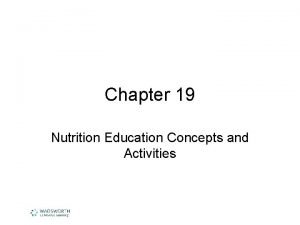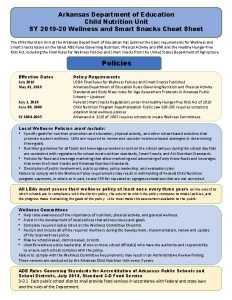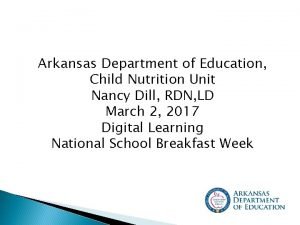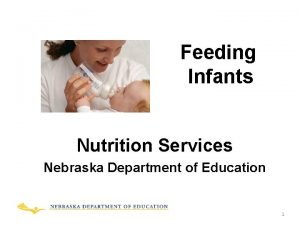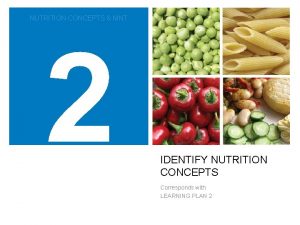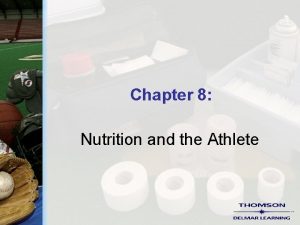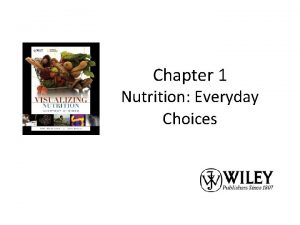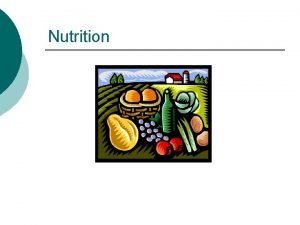Chapter 19 Nutrition Education Concepts and Activities Learning














- Slides: 14

Chapter 19 Nutrition Education Concepts and Activities

Learning Objectives After studying this chapter, you should be able to: • Explain why it is important to educate young children about nutrition and the role schools and families play I this process. • Summarize the basic nutrition concepts and safety considerations that must be addressed in planning learning experiences for children. • Discuss the principles of effective curriculum and lesson development. • Identify several additional sources that influence children’s ideas about food and nutrition.

Fundamental Concepts of Nutrition Education • Children’s growth and health are dependent on having access to nutrientdense food. • Nutrients are obtained from food. • A variety of foods must be consumed to get all nutrients needed for healthy growth and development. • Food safety and sanitation are especially critical as they relate to young children.

Family Involvement • Family participation in children’s nutrition education is fundamental to achieving success. – Explain what this statement means and why it is true. • In what ways can schools involve families in children’s nutrition education? © 2012 Cengage Learning. All Rights Reserved.

Children’s Nutrition Education • Teachers have many opportunities to weave nutrition education throughout children’s daily learning experiences. – Describe how teachers can achieve this goal. – What are the benefits of providing educational experiences for children in this manner? – What other areas of children’s development can be reinforced through nutrition education experiences? © 2012 Cengage Learning. All Rights Reserved.

Principles of Instructional Design • Learning activities should be developmentally appropriate. • Actual foods should be used in activities whenever possible (check for allergies). • Only nutrient-dense foods should be used in learning experiences. • Children should be able to eat the end product. • Children learn best when they are involved. © 2012 Cengage Learning. All Rights Reserved.

Principles of Instructional Design (continued) • Select a topic: – Choose topics that are developmentally appropriate, based on children’s interests, and respectful of cultural differences. – Develop long-range plans that build children’s understanding and skills (scaffolding). – Take advantage of teachable moments when opportunities present themselves. © 2012 Cengage Learning. All Rights Reserved.

Principles of Instructional Design (continued) • Develop behavioral objectives to: – Guide content and organization – Identify expected outcomes – Help in deciding how a topic or theme should be presented – Evaluate the lesson’s effectiveness (in achieving learning objectives) © 2012 Cengage Learning. All Rights Reserved.

Principles of Instructional Design (continued) • What are behavioral objectives? • Provide several examples of measurable objectives. • How would you change the following statement so that it is a behavioral objective? – The children will know that nutritious food is good for them. © 2012 Cengage Learning. All Rights Reserved.

Principles of Instructional Design (continued) • Consider children’s safety: – Always check for children’s food allergies. – Teachers and children must wash their hands before starting an edible project. – Avoid using foods that are a choking hazard. – Children must sit down to eat. – Use only unbreakable equipment. – Avoid sharp objects that could injure children. – Provide enough equipment so that children do not have to wait. © 2012 Cengage Learning. All Rights Reserved.

Principles of Instructional Design (continued) • Consider and select instructional methods: – Can affect children’s interest and learning – Should only focus on one or two concepts – Should be limited in length (time) based on children’s attention spans – Should be infused with visual media – Should include children’s hands-on participation and practice © 2012 Cengage Learning. All Rights Reserved.

Principles of Instructional Design (continued) • What instructional methods would be engaging and effective to use with: – Infants? – Toddlers? – Preschool-age children? – School-age children? © 2012 Cengage Learning. All Rights Reserved.

Principles of Instructional Design (continued) • Evaluation should: – be ongoing – be based on the learning objectives – assess the effectiveness of all aspects of the learning experience – yield information that can be used for improvement © 2012 Cengage Learning. All Rights Reserved.

Information Sources That Influence Children’s Eating Habits • Where do children learn about food? • How do these sources influence children’s eating habits? © 2012 Cengage Learning. All Rights Reserved.
 To-ze manjerico
To-ze manjerico Basic nutrition concepts
Basic nutrition concepts Foods used in nutrition activities should be nutrient-dense
Foods used in nutrition activities should be nutrient-dense Outdoor sports name
Outdoor sports name Primary and support activities
Primary and support activities Primary and secondary activities
Primary and secondary activities Cuadro comparativo e-learning b-learning m-learning
Cuadro comparativo e-learning b-learning m-learning Operating activities vs investing activities
Operating activities vs investing activities Child nutrition unit arkansas
Child nutrition unit arkansas Arkansas department of education child nutrition unit
Arkansas department of education child nutrition unit Cacfp nebraska
Cacfp nebraska Photosynthesis learning objectives
Photosynthesis learning objectives Kelsey carbonetta
Kelsey carbonetta Chapter 7 nutrition and your fitness
Chapter 7 nutrition and your fitness Chapter 5 lesson 1 health
Chapter 5 lesson 1 health


